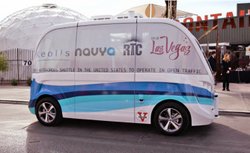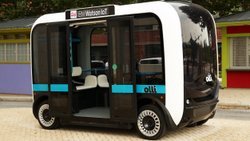Your Personal Ride To the Future
More than 200 years since local public transportation appeared in European and American cities, its basic idea looks and functions pretty much the same as when it started. In most cities, trains and buses are still the primary forms of public transportation.
The French company Navya thinks they have an answer that looks different—and the answer is named Arma. Recently brought to the streets of Las Vegas, the small oval-shaped shuttle has a human attendant, but no steering wheel or brake pedal.
Using GPS, electronic curb sensors and additional technology, the Arma doesn’t need lane lines to make its way along busy Fremont Street between Las Vegas Boulevard and Eighth Street — right in the thick of regular traffic.
Not Speedy, But Neither Is Anyone Else

Arma holds 12 passengers, and can reach a top speed of 27 mph. However, it will only “speed” up to 12 mph during a two-week test period, the Las Vegas Sun reported.
The vehicle has a range of about 90 miles for each electric charge and takes about five to eight hours to recharge.
Since first testing the Arma in France in late 2015, Navya vehicles have transported more than 100,000 people, and the fleet has grown to 30 and is in use in seven countries around the world, including the United States.
The U.S. Option
Navya is not the only company pioneering the future of public transportation. American company, Local Motors, showcased its self-driving bus, Olli, on the streets of Washington, DC in June of 2016.
Similar to Arma, Olli is a small, oval-shaped, fully electric and autonomous shuttle. Unlike Arma, however, the only attendant you will find in Olli is its integrated IBM Watson cloud-based cognitive computing system.

Watson’s main function is to analyze and learn from high volumes of transportation data produced by more than 30 sensors embedded throughout the vehicle. Olli’s main party piece, however, is the integration of Watson into the user experience.
Much like Apple’s Siri or Amazon’s Alexa, Watson can understand and respond to passengers’ questions as they enter the vehicle, including questions about destinations (“Olli, can you take me downtown?”) or specific vehicle functions (“How does this feature work?” or even “Are we there yet?”).
After its successful first launch in early 2016, Local Motors plans to bring Olli to more cities around the U.S. in the near future. One unique feature of Olli is that it is designed to be produced locally with the majority of the vehicle created via 3D printing.
As start-ups and tech companies race to find the future of transportation, it sometimes seems as though innovation is pushed simply for the sake of innovation.
Are self-driving shuttles like Arma and Olli the future of public transportation, or are they simply a stepping stone to the next big thing? Only time will tell.

2 thoughts on “News: Self-driving buses: the future of public transportation?”